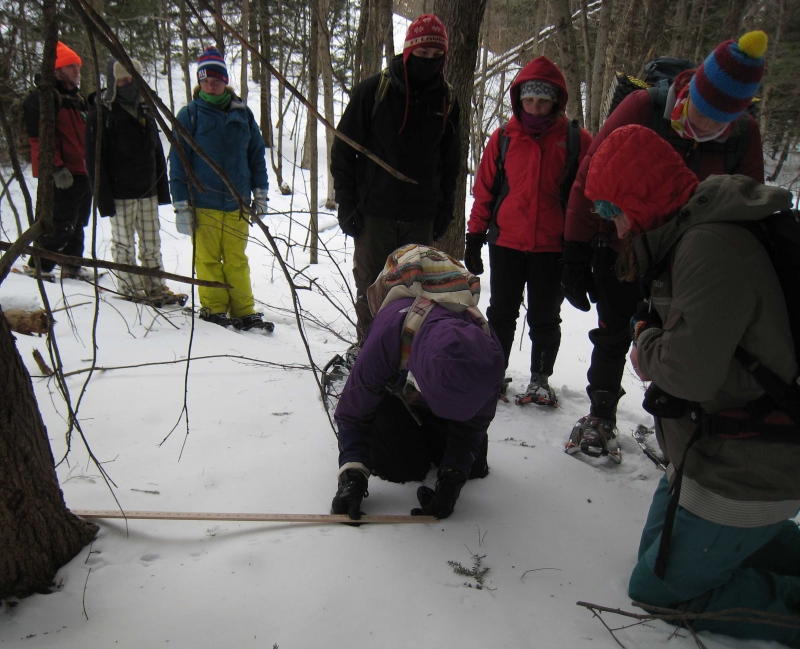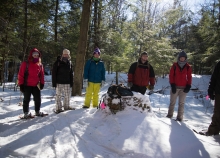
Tracking, Trees, and Tranquility: An Afternoon in Glenmeal
This winter Nature Up North is featuring a Winter Ecology Series, in which St. Lawrence University students in Dr. Karl McKnight's Winter Ecology course share their observations from a weekly field trip to Glenmeal State Forest in Pierrepont. We hope you enjoy their accounts from days spent in the woods examining the fascinating ways plants and animals endure the North Country winter.
By Samantha Haab
30 January 2014 Snow depth 28.5 cm Snow Density 0.22 g/cm3
This past Thursday my classmates and I were fortunate enough to spend the duration of our weekly Winter Ecology lab hiking through the serene woods of Glenmeal State Forest. With snowshoes and plenty of winter gear to keep us warm, we observed animal tracks, identified trees, and enjoyed the unusually warm and sunny weather (temperatures were above zero for a change). With a fresh covering of snow, animal tracks were clearly visible and abundant throughout the forest. The tracks we saw belonged to voles, mice, chipmunks, porcupines, coyotes, fishers, squirrels, and deer. We looked at various characteristics of the tracks to aid in identification including width, length, the presence of tail drag, and the distance between bounds. We also saw evidence of several potential grouse or owl markings where their wings had made distinct impressions in the snow during either landing or takeoff.

We visited various sites within the forest, including a vernal pool containing the bodies of hundreds of frozen wood frogs that will thaw out and begin to lay eggs as soon as the ice begins to melt. We also saw a porcupine, which was pretty exciting. Its face was hidden in some rocks, which we learned was a defense mechanism. Porcupines do not have quills protecting their face, so when confronted with a threat they will try to bury their face in nearby holes or between rocks—their main predators in Glenmeal are fisher cats. We also collected data while in the woods, measuring the snow depth, snow weight, and temperature. To aid us in our data collection we set up temperature probes, hanging them from trees at varying heights to see if there is a difference in temperature closer to or further from the snow (results pending).

We eventually got hungry and each of us headed off independently to a site within the forest to eat our lunch. If you have never eaten lunch alone in the middle of the woods in winter before, I would highly recommend it! It was quiet, peaceful, refreshing, and only a little bit cold—but bring a thermos of hot chocolate or warm soup and I’m sure it would be grand. Being alone surrounded by nature is a great way to clear your mind, and I for one found it to be relaxing and fun. After lunch, we hiked through the forest some more, continuing to look at animal tracks while also identifying some trees along the way. We identified Yellow Birch, Eastern Hemlock, Musclewood, and Hophornbeam trees. By chewing on some twigs we learned that Yellow Birch tastes like spearmint. Additionally, we learned that Hophornbeam trees have distinctive, peeling bark and they do not get very big and that Musclewood has interesting, segmented bark that looks like a flexed muscle (hence the name).
We eventually made our way out of the woods and headed back to campus, eagerly awaiting next week for our chance to do it all over again.

